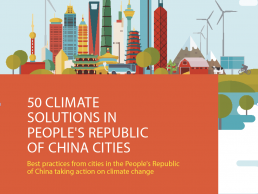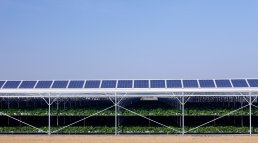First appeared in

Asian Development Bank
50 climate solutions from cities in the People's Republic of China
Solar panels on greenhouses will not only provide energy to the central grid, but also contribute to growing organic products in Hanchuan in a green symbiosis.
Generating renewable solar energy requires a lot of space, but in Hanchuan there are great pressures on the land for agriculture, housing, and other needs. In a move to combine two land uses, the city has installed PV solar power systems on 42 greenhouse roofs covering 33 hectares (ha) of farmland. The system delivers 8,841 megawatt-hours (MWh) annually to the national grid and has a lifetime of 25 years. Organic agricultural products with high value added, such as edible fungus, selenium-enriched tea, and flowers are grown in the greenhouses.
8K
TONS CO2 EMISSIONS ARE AVOIDED EACH YEAR BECAUSE OF THE INSTALLED 10 MW SOLAR POWER SYSTEM.
The total installed capacity is 10 megawatts (MW). A local private solar energy firm has provided funds for the construction of the greenhouses and PV power generation system, while subsidies from both the central and Hubei provincial governments bring in CNY0.8 per kilowatt-hour (kWh). Ambitious plans are afoot to increase the capacity by a factor of 10 to a total of 100 MW.

By combining agriculture and energy generation, Hanchuan is making the most out of its valuable land (photo by Hongmin Dong).
The Challenge
While solar power generation becomes an increasingly attractive alternative to coal, a great deal of land is needed to scale up generation. In Hanchuan, where farmland is valuable to local livelihoods, the two uses of farming and renewable energy generation have been combined to create a win-win situation for farmers and the environment.
Co-Benefits
Economic By converting arable land to greenhouses with solar roofs, the value of the land is significantly increased, bringing greater economic prosperity to local farmers.
Environment Besides the 8,000 tons of annual CO2 emissions avoided, the project also reduces emissions of SO2 and NOX, which would have resulted from the combustion of fossil fuels.
Social The project helped to create employment opportunities for the local people during the construction, operation, and maintenance of PV power generation system and greenhouses. In addition, the greenhouses ensure access to a safe and healthy food source.

